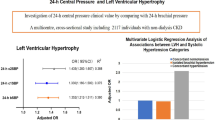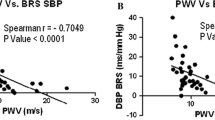Abstract
Objective
Orthostatic hypotension (OH) has a significant association with cardiovascular disease. OH becomes more common in older age, as does arterial stiffness, shown to be independently associated with impaired baroreflex sensitivity and OH. Measurement of arterial compliance and central blood pressures are increasingly important, with evidence that central BP more closely correlates to end-organ damage and mortality than peripheral measurements. Patients with chronic kidney disease (CKD) are high risk for cardiovascular events, which can be predicted through measures of arterial compliance. We hypothesised that OH is associated with arterial stiffness and central blood pressure in CKD patients.
Design/setting
We tested this hypothesis within the arterial compliance and oxidant stress as predictors of loss of renal function, morbidity and mortality in chronic kidney disease (ACADEMIC) study, a single-centre prospective observational study of the progression of arterial stiffness and renal function.
Participants
One hundred and forty-six patients with CKD 3 or 4.
Measurements
Twenty-four-hour ambulatory BP monitoring with postural sensing (DIASYS Integra 2, Novacor France); central systolic and diastolic BP (cSBP and cDBP) and aortic Augmentation Index using Sphygmocor® (Atcor, Australia); Carotid-femoral pulse wave velocity (cfPWV) using Complior® (ALAM Medical, France).
Results
Twenty-three patients had a postural SBP fall (prevalence 15.8%), with mean drop 7 mmHg. Patients with OH had higher cfPWV (15.2 m/s vs 12.7 m/s in patients without OH, p < 0.001) and central SBP (147.5 vs 135.7, p = 0.012). Regression analysis gave an odds ratio (OR) of orthostatic SBP fall for cfPWV of 1.46 (95% CI 1.16–1.84, p = 0.001) and 1.03 for cSBP (95% CI 1.004–1.06, p = 0.024) after adjustment for cardiovascular risk factors.
Conclusion
Aortic stiffness and central SBP are independently associated with orthostatic SBP fall in CKD patients. This suggests that enhanced arterial stiffness may be an underlying mechanism in baroreflex dysfunction, and may partly explain the vascular risk in CKD patients.

Similar content being viewed by others
References
Freeman R (2008) Neurogenic orthostatic hypotension. N Engl J Med 358:615–624
Xin W, Lin Z, Li X (2013) Orthostatic hypotension and the risk of congestive heart failure: a meta-analysis of prospective cohort studies. PLoS One 8(5):e63169
Franceschini N, Rose KM, Astor BC et al (2010) Orthostatic hypotension and incident chronic kidney disease: the atherosclerosis risk in communities study. Hypertension 56(6):1054–1059
Xin W, Lin Z, Mi S (2013) Orthostatic hypotension and mortality risk: a meta-analysis of cohort studies. Heart. https://doi.org/10.1136/heartjnl-2013-304121(published online first 22 July 2013)
Angelousi A, Girerd N, Benetos A et al (2014) Association between orthostatic hypotension and cardiovascular risk, cerebrovascular risk, cognitive decline and falls as well as overall mortality: a systematic review and meta-analysis. J Hypertens. 32(8):1562–1571 (discussion 71)
Low PA (2008) Prevalence of orthostatic hypotension. Clin Auton Res 18(Suppl 1):8–13
Freeman R, Wieling W, Axelrod FB et al (2011) Consensus statement on the definition of orthostatic hypotension, neurally mediated syncope and the postural tachycardia syndrome. Clin Auton Res 21(2):69–72
Valbusa F, Labat C, Salvi P et al (2012) Orthostatic hypotension in very old subject living in nursing homes: the PARTAGE study. J Hypertens 30:53–60
Sutton-Tyrrell K, Najjar SS, Boudreau RM et al (2005) Elevated aortic pulse wave velocity, a marker of arterial stiffness, predicts cardiovascular events in well-functioning older adults. Circulation 111(25):3384–3390
Bulpitt CJ, Cameron JD, Rajkumar C et al (1999) The effect of age on vascular compliance in man: which are the appropriate measures? J Hum Hypertens 13(11):753–758
Ben-Shlomo Y, Spears M, Boustred C et al (2013) Aortic pulse wave velocity improves cardiovascular event prediction: an individual participant meta-analysis of prospective observational data from 17,635 subjects. J Am Coll Cardiol S07351097(13) 0597–3
Mattace-Raso FU, van den Meiracker AH, Bos WJ et al (2007) Arterial stiffness, cardiovagal baroreflex sensitivity and postural blood pressure changes in older adults: the Rotterdam Study. J Hypertens 25(7):1421–1426
Mattace-Raso FU, van der Cammen TJ, Knetsch AM et al (2006) Arterial stiffness as the candidate underlying mechanism for postural blood pressure changes and orthostatic hypotension in older adults: the Rotterdam Study. J Hypertens 24(2):339–344
Protogerou AD, Stergiou GS, Lourida P et al (2008) Arterial stiffness and orthostatic blood pressure changes in untreated and treated hypertensive subjects. J Am Soc Hypertens 2(5):372–377
Sharman JE, Marwick TH, Gilroy D et al (2013) Randomized trial of guiding hypertension management using central aortic blood pressure compared with best-practice care: principal findings of the BP GUIDE study. Hypertension 62(6):1138–1145
Almutary H, Bonner A, Douglas C (2013) Symptom burden in chronic kidney disease: a review of recent literature. J Renal Care 39(3):140–150
Temmar M, Liabeuf S, Renard C et al (2010) Pulse wave velocity and vascular calcification at different stages of chronic kidney disease. J Hypertens 28(1):163–169
Chue CD, Townend JN, Steeds RP et al (2010) Arterial stiffness in chronic kidney disease: causes and consequences. Heart 96(11):817–823
Roumelioti ME, Buysse DJ, Sanders MH et al (2011) Sleep-disordered breathing and excessive daytime sleepiness in chronic kidney disease and hemodialysis. Clin J Am Soc Nephrol 6(5):986–994
Bhat S, Hegde S, Szpunar S (2013) Orthostatic blood pressure (BP) variance in a chronic kidney disease (CKD) clinic. J Clin Hypertens 15(Suppl 1):72 [abstract]
Sasaki O, Nakahama H, Nakamura S et al (2005) Orthostatic hypotension at the introductory phase of haemodialysis predicts all-cause mortality. Nephrol Dial Transplant 20(2):377–381
Liu K, Wang S, Wan S et al (2016) Arterial stiffness, central pulsatile hemodynamic load, and orthostatic hypotension. J Clin Hypertens (Greenwich) 18(7):655–662
O’Brien E, Asmar R, Beilin L et al (2005) Practice guidelines of the European Society of Hypertension for clinic, ambulatory and self blood pressure measurement. J Hypertens 23(4):697–701
Ejaz AA, Kazory A, Heinig ME (2007) 24-Hour blood pressure monitoring in the evaluation of supine hypertension and orthostatic hypotension. J Clin Hypertens 9:952–955
Minutolo R, Borrelli S, Scigliano R et al (2007) Prevalence and clinical correlates of white coat hypertension in chronic kidney disease. Nephrol Dial Transplant 22(8):2217–2223
Stuebner E, Vichayanrat E, Low DA et al (2013) Twenty-four hour non-invasive ambulatory blood pressure and heart rate monitoring in Parkinson’s disease. Front Neurol 4:49
Mojón A, Ayala DE, Piñeiro L et al (2013) Comparison of ambulatory blood pressure parameters of hypertensive patients with and without chronic kidney disease. Chronobiol Int 30(1–2):145–158
Ford ML, Tomlinson LA, Chapman TP et al (2010) Aortic stiffness is independently associated with rate of renal function decline in chronic kidney disease stages 3 and 4. Hypertension 55(5):1110–1115
Burden R, Tomson C (2005) Identification, management and referral of adults with chronic kidney disease: concise guidelines. Clin Med 5:635–642
Sever P (2006) New hypertension guidelines from the National Institute for Health and Clinical Excellence and the British Hypertension Society. J Renin Angiotensin Aldosterone Syst 7:61–63
Laurent S, Cockcroft J, Van Bortel L et al (2006) Expert consensus document on arterial stiffness: methodological issues and clinical applications. Eur Heart J 27(21):2588–2605
Masaki KH, Schatz IJ, Burchfiel CM et al (1998) Orthostatic hypotension predicts mortality in elderly men: the Honolulu Heart Program. Circulation 98(21):2290–2295
Naschitz JE, Rosner I (2007) Orthostatic hypotension: framework of the syndrome. Postgrad Med J 83:568–574
Rose KM, Tyroler HA, Nardo CJ et al (2000) Orthostatic hypotension and the incidence of coronary heart disease: the Atherosclerosis Risk in Communities study. Am J Hypertens 13(6 Pt 1):571–578
Boddaert J, Tamim H, Verny M et al (2004) Arterial stiffness is associated with orthostatic hypotension in elderly subjects with history of falls. J Am Geriatr Soc 52(4):568–572
Luukinen H, Koski K, Laippala P et al (1999) Prognosis of diastolic and systolic orthostatic hypotension in older persons. Arch Intern Med 159(3):273–280
Applegate WB, Davis BR, Black HR et al (1991) Prevalence of postural hypotension at baseline in the Systolic Hypertension in the Elderly Program (SHEP) cohort. J Am Geriatr Soc 39(11):1057–1064
Pasierski T, Pearson AC, Labovitz AJ (1991) Pathophysiology of isolated systolic hypertension in elderly patients: Doppler echocardiographic insights. Am Heart J 122(2):528–534
Boddaert J, Tamim H, Verny M et al (2004) Arterial stiffness is associated with orthostatic hypotension in elderly subjects with history of falls. J Am Geriatr Soc 52(4):568–572
Chesterton LJ, Sigrist MK, Bennett T et al (2005) Reduced baroreflex sensitivity is associated with increased vascular calcification and arterial stiffness. Nephrol Dial Transplant 20(6):1140–1147
Monahan KD, Dinenno FA, Seals DR et al (2001) Age-associated changes in cardiovagal baroreflex sensitivity are related to central arterial compliance. Am J Physiol Heart Circ Physiol. 281(1):H284–H289
Sabbah HN (2012) Baroreflex activation for the treatment of heart failure. Curr cardiol Rep 14(3):326–333
Hoshide S, Kario K, Eguchi K et al (2005) Altered aortic properties in elderly orthostatic hypertension. Hypertens Res 28:15–19
Metzler M, Duerr S, Granata R et al (2013) Neurogenic orthostatic hypotension: pathophysiology, evaluation, and management. J Neurol 260:2212–2219
Joyner MJ, Charkoudian N, Wallin BG (2010) Sympathetic nervous system and blood pressure in humans individualized patterns of regulation and their implications. Hypertension 56:10–16
Januszko-Giergielewicz B, Gromadziński L, Dudziak M, Dębska-Ślizień A (2019) Orthostatic hypotension in asymptomatic patients with chronic kidney disease. Medicina 55(4):113
Chan KE, Ikizler TA, Gamboa JL et al (2011) Combined angiotensin-converting enzyme inhibition and receptor blockade associate with increased risk of cardiovascular death in hemodialysis patients. Kidney Int 80(9):978–985
Freeman R (2008) Neurogenic orthostatic hypotension. N Engl J Med 358:615–624
Williams B, Lacy PS, Thom SM et al (2006) Differential impact of blood pressure-lowering drugs on central aortic pressure and clinical outcomes: principal results of the Conduit Artery Function Evaluation (CAFE) study. Circulation 113(9):1213–1225
Roman MJ, Devereux RB, Kizer JR et al (2007) Central pressure more strongly relates to vascular disease and outcome than does brachial pressure: the Strong Heart Study. Hypertension 50(1):197–203
Ohno Y, Kanno Y, Takenaka T (2016) Central blood pressure and chronic kidney disease. World J Nephrol. 5(1):90–100
Naschitz JE, Rosner I (2007) Orthostatic hypotension: framework of the syndrome. Postgrad Med J 83:568–574
Tomlinson LA, Holt SG, Leslie AR et al (2009) Prevalence of ambulatory hypotension in elderly patients with CKD stages 3 and 4. Nephrol Dial Transplant 24(12):3751–3755
Funding
None.
Author information
Authors and Affiliations
Contributions
FK study data analysis, interpretation, manuscript preparation. PR data analysis, interpretation, manuscript preparation. NP data analysis, interpretation, manuscript preparation. SH study design and conception, acquisition of data, manuscript preparation. CR study design and conception, acquisition of data, analysis, interpretation, manuscript preparation.
Corresponding author
Ethics declarations
Conflict of interest
The authors declare that they have no conflict of interest.
Ethical approval
This study was approved by the West Sussex Research Ethics Committee and was conducted in accordance with Good Clinical Practice Guidelines and the Declaration of Helsinki.
Informed consent
Patients gave written informed consent.
Additional information
Publisher's Note
Springer Nature remains neutral with regard to jurisdictional claims in published maps and institutional affiliations.
Rights and permissions
About this article
Cite this article
Kirkham, F.A., Rankin, P., Parekh, N. et al. Aortic stiffness and central systolic pressure are associated with ambulatory orthostatic BP fall in chronic kidney disease. J Nephrol 33, 317–324 (2020). https://doi.org/10.1007/s40620-019-00655-6
Received:
Accepted:
Published:
Issue Date:
DOI: https://doi.org/10.1007/s40620-019-00655-6




